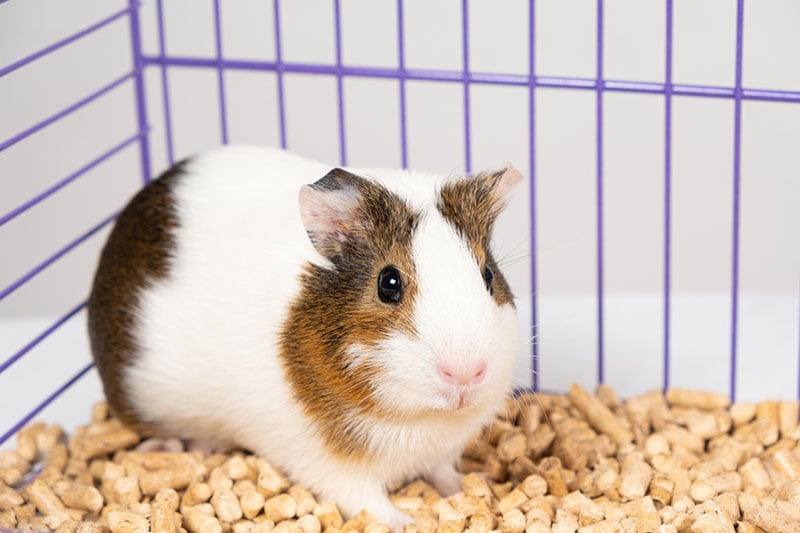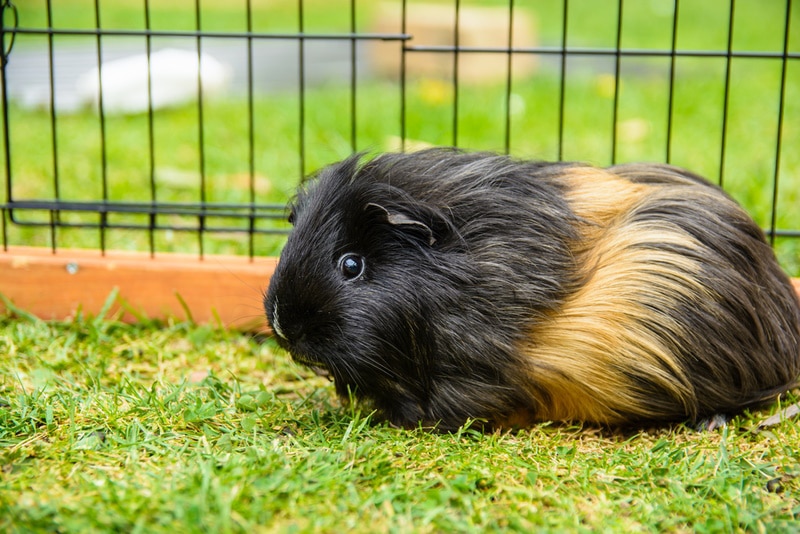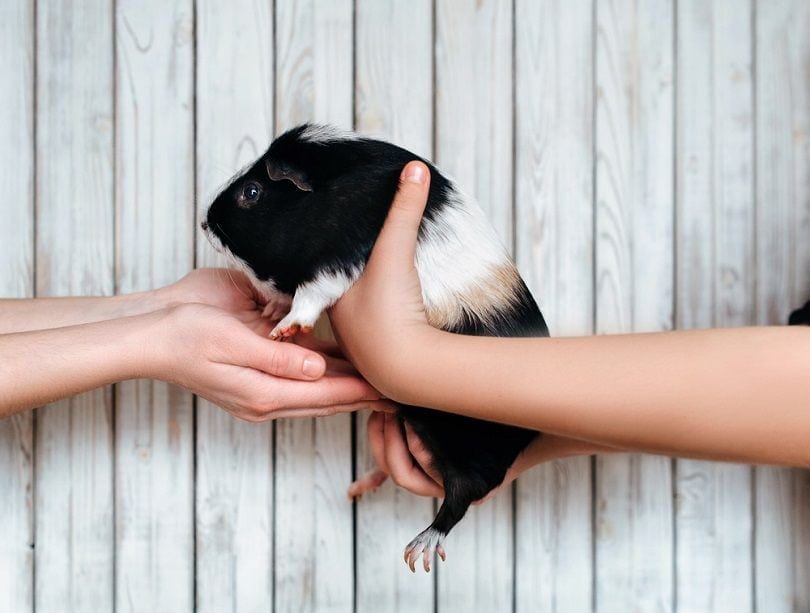How Much Space Does a Guinea Pig Need? Size Chart & FAQ
Updated on

A healthy guinea pig is active, vocal, and playful. If your guinea pig is inactive, hides a lot, and inhabits antisocial behaviors, they may be bored. However, if your guinea pig has many things to do and chew on, the problem relies solely on how much space they have.
One guinea pig should have a minimum of 5 to 7 square feet of space.1 When adding new guinea pigs, you’ll need to increase the size of each guinea pig.
In this article, you’ll learn how much space is required per guinea pig and how to build the perfect home for your pocket pals.
Click to Skip Ahead:
- Why Does Size Matter?
- Size Chart for Multiple Guinea Pigs
- The More Space, the Better
- Cage Options
- Building the Perfect Guinea Pig Cage
- Indoor vs. Outdoor Habitats
- Keeping Your Guinea Pig Healthy, Safe, and Happy
Why Does Size Matter?
Pet rodents, such as gerbils, hamsters, mice, and rats, can jump, climb, and use exercise wheels. Guinea pigs aren’t flexible enough to run on wheels, jump high or long distances, and climb. It’s this reason why size matters.
Some guinea owners opt for multi-floor housing with ramps to still utilize their own space for living conditions. While it may be a good idea to use ramps and multi-floor housing, you must make sure that each floor is easily accessible and that the size requirements are what your guinea pig desires, although there are better options than multi-floor housing for safety reasons.
Having room to roam stimulates the guinea pig’s brain and decreases its chances of developing health issues like heart disease. If your cage is big enough, you’ll save time spending more time on your responsibilities rather than taking an extra step daily to bring your guinea pigs outside. However, it’s still a good idea to build a run or playpen for your guinea pigs.

Size Chart for Multiple Guinea Pigs
Since guinea pigs are social creatures, it is recommended to always get two or more guinea pigs for the health and well-being of each pocket pig. Below is a table that represents the best cage size for your guinea pigs:
| One guinea pig | 5–7 square feet |
| Two guinea pigs | 7.5–10 square feet |
| Three guinea pigs | 10.5–13 square feet |
| Four guinea pigs | 13–16 square feet |
| Five or more guinea pigs | 16–18 square feet |
Do you see a pattern? One guinea pig needs at least 7 square feet of space. If you add another guinea pig, the space goes up 3 more square feet. For every guinea pig you add, you’ll need to add 3 feet onto the enclosure.
The More Space, the Better
There are more risks to owning a small cage for convenience than benefits to owning a larger cage. The first thing you must do before getting a guinea pig or adding more piggies is consider caging options. How many pocket pigs do you intend to have? If your answer is three or more (since you should always have two right away), you must compensate for that immediately.
No matter how many guinea pigs you have, the more space you can provide them, the better and healthier they’ll be.
- They will be more active
- Fewer fights due to personal space
-
Less illness or long-term sickness, including:
- Heart diseases
- Diabetes
- Obesity
- Bumblefoot
- Vocal and more communicative guinea pigs—a sign of happiness
- Happier guineas
- More stimulation, meaning healthier brain function
- Bigger cages are easier to clean
- Decreases the chances of respiratory issues
- They can naturally express themselves, while dominance and territorial behaviors are established quicker
Overall, the more space you provide your guinea pigs, the safer and happier they will be. The happier your guinea pig is, the healthier they stay throughout their lives.

Cage Options
Guinea pig habitats can be indoor or outdoor enclosures. The most recommended enclosures are C&C (cubes and coroplast) cages. C&C cages are the most inexpensive and easy do-it-yourself cages that can be customized to suit your needs and your guinea pigs.
Cages resembling wire flooring, plastic tubing or bins, and glass or sealed aquariums are unsafe for your guinea pigs. Materials like glass, plastic, and wire can harm or injure your guinea pigs, so C&C is the most well-known and stable option.
However, you can use canvas bottoms and wire walls if you want a smaller option. Though with smaller options, it’s best to get a run or a playpen for your guinea, so they can exercise outside their enclosure.
Hutches are also a great and sturdy option, though they are more suited for outside purposes.
Building the Perfect Guinea Pig Cage
A few options exist for building the perfect cage for your guinea pigs. However, deciding whether your guinea pigs are indoor or outdoor pets would be best. For outdoor guinea pigs, they’ll need treated wood habitats such as hutches. However, you can make your own guinea pig habitat using treated wood and other safe materials
C&C cages are great for the indoors, allowing you to get creative to suit your piggies’ needs. Some cages have multiple floors, though it’s only recommended if you build a low ramp with railings for your guinea’s safety. Remember that if you plan on having multiple floors for your guinea pigs, each floor has railings and secure walls and flooring.
Whatever the case, building your perfect guinea pig cage must meet requirements. Ensure there is enough room for your guinea pigs and their food, hides, bedding, and toys.

Indoor vs. Outdoor Habitats
Indoor guinea pigs vs. outdoor guinea pigs each have pros and cons. We’ve listed them here:
| Indoor Pros | Indoor Cons |
| Notice signs of illness quicker | May be inconvenient for your living conditions |
| Protection from cats and other mammals | House may smell more (like a barn) |
| Temperature is easier to regulate | May cause space issues |
| Bond quicker and easier | Housing damage to remotes, electrical wires, and furniture (if you let them roam freely) |
| Can instantly prevent or break up fights |
| Outdoor Pros | Outdoor Cons |
| Larger cages | Harder to maintain a suitable temperature |
| More ventilation | Not-so-easy access to your pet in emergent situations |
| Less stink | May not be able to break up fights |
| Less noise or annoyance for you inside | Harder to bond |
| Guinea pigs adapt well to nature where TV and kids aren’t scaring them. | If the cage is unstable, predators will have an easier time getting to them |
Keeping Your Guinea Pig Healthy, Safe, and Happy
While having more space is best, it isn’t the most essential thing, so don’t stress if you cannot compensate for your piggies’ spatial requirements. Let’s say you really want a guinea pig, but your home will not provide it with the spatial requirements it desires; ensure you have a run or playpen handy for them to exercise elsewhere in your home.
The most important thing you can do to keep your guinea pigs happy and healthy is to provide them with adequate nutrition daily. This includes hay, fruit and vegetables, pellets, and an unlimited water source.
If you’re concerned about their daily exercise, you can set up indoor and outdoor habitats. Who says you can’t have a hutch outside and a stable cage inside?
Final Words
The minimum recommended space requirement for one guinea pig is 5 to 7 square feet, although the more room you can supply, the better. For every guinea pig you add, ensure you compensate for at least 3 more square feet of room.
If the space is an issue for you, there are alternative options such as multi-floor households. Remember, safety comes first. You can set up playpens and runs for your guinea pigs, and who says you can’t have an enclosure that exists outside?
Featured Image Credit: Garna Zarina, Shutterstock











